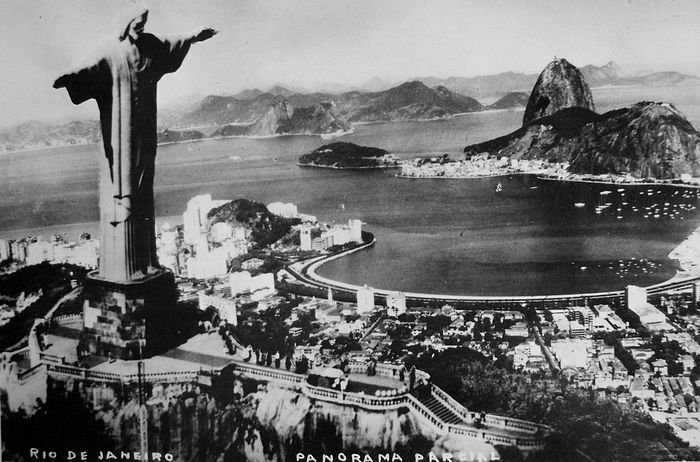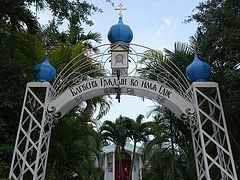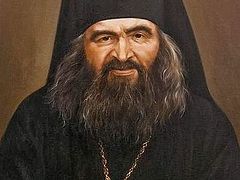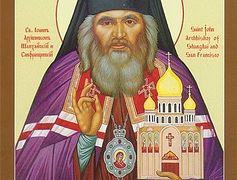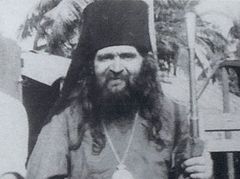They Preserved Their Love for Russia
In America you meet Russian émigrés who only a few years after arriving begin speaking in an odd mix of English and Russian, and complain that they are forgetting their native tongue. Ever more impressive are those Russian people who found themselves in a foreign land because of some terrible historic cataclysm, endured all the sorrows of a refugee life, spent their entire lives abroad, but speak a pure, unadulterated Russian hearkening back to pre-Revolutionary times. This is simply amazing, but even having mastered English or even other languages, they have managed to preserve the Russian language. They also preserved their love for Russia—even those who had never set foot in the country, but only heard about it from their parents.
The heroine of my story, Ekaterina Dmitrievna, is among this group. The horrifying whirlwind of change blew her family from Harbin, China, to Tianjin, then Hong Kong, then further: to Brazil and finally California. In several nations, three continents, and everywhere was the bitter bread of exile, foreign languages and traditions, alien religions. These Russians carried their Orthodox Christian faith like a candle in the harsh wind, and preserved the flame, becoming emissaries of their Homeland in distant lands.
Harbin
Ekaterina’s paternal grandfather, Semen Gumenyuk, was an engineer who worked on the Eastern Chinese Railroad. Gradually it became the largest Russian project in Manchuria, and tens of thousands of Russians went to work there.
Gradually the little Chinese town of Haobin near a bridge over the river Sungari was transformed into the city of Harbin, a center of Russian railroad employees. By agreement with the Chinese, Russia could not send regular troops into Manchuria, so security was provided by the railroad: five hundred cavalrymen, 200 of whom were Kuban Cossacks.
Ekaterina’s maternal grandmother was well off, owning large flocks of sheep. Her grandmother and her sister, both teachers, came to Harbin from Samara.
There were 20 working Orthodox churches in Harbin. There were Russian schools and colleges, a symphony orchestra, opera, dramatic theater and even a ballet troupe directed by artists from the Imperial Moscow Ballet Company.
Harbin was unique because of its geographical location; even after 1917, a part of pre-Revolutionary Russia remained with her traditions, Orthodox faith and the ideal of serving the Fatherland.
Ekaterina’s parents were born in Harbin: Dmitry Semenovich Gumenyuk, was born in 1920, and her mother Galina Alexeevna was born in 1922. They met and got married in Harbin, and in 1944, Katyusha was born. Her father worked as a mechanic, while the young mother reared her daughter.
Katya studied in a Soviet school for five happy years, with friends, school, church… Katya loved attending church and sang together with her grandmother.
How Icons Began to Renew Themselves
Suddenly, icons in churches began to brighten. Katya saw this with her own eyes. In 1952, the Soviet Union granted full administration of the railway to the government of the Chinese People’s Republic without remuneration. Everything the Russians worked for under the Tsars was gone. But before this, icons in churches were renewing themselves—Katya witnessed this miracle firsthand.
One day the Chinese shuttered one of the churches, intending to turn it into a warehouse, and suddenly saw the fresco in the dome suddenly shine. Then the iconostasis began to brighten. The Chinese were frightened by this wondrous spectacle and rushed out of the church.
Before leaving her hometown, many Russians in Harbin would pray before an icon displayed in the train station of St Nicholas, the patron saint of travelers. Even many Chinese revered this image.
Many years later in San Francisco, Katya met Abbess Ariadna (Michurina), who always brought a painted Vladimir Icon of the Mother of God wherever she was forced to relocate to. This icon also brightened in her very hands in Harbin while still a young novice and witnessed by her spiritual mother Abbess Rufina in 1925.
 Vladyka John with the inhabitants of the Vladimir Icon of the Theotokos Monastery, Abbess Ariadna, clergy, and the wards of the Olginsk shelter at the monastery
Vladyka John with the inhabitants of the Vladimir Icon of the Theotokos Monastery, Abbess Ariadna, clergy, and the wards of the Olginsk shelter at the monastery A Corner of Old Russia
What was left for the Russians in Harbin after so many years of hard work on the railroad? The Russian presence sadly came to an end in China. Many Russians of Harbin returned to the Soviet Union: they were promised jobs, housing and a happy life. Instead, they received prison-camp sentences. Katya’s uncle, a violin player, also went to the USSR: his wife yearned to go home.
Fortunately, her uncle’s family eluded imprisonment, but they were sent to a settlement in Kazakhstan, where the talented musician was forced to work as a shepherd. His grandfather was the owner of large flocks, but his grandson was a simple shepherd.
Katya’s parents only left Harbin much later than most others, in 1955. Instead of prison camp in the Soviet Union, they resettled in Tianjin.
Wandering in Foreign Lands
Katya’s family did not tarry in Tianjin: in 1949, Mao-Tse Tung’s communists came to power in China. Then all foreign-owned businesses were taken over by Chinese, while enemies of communism were imprisoned or killed. It became very dangerous for Russians to stay in Tianjin.
Katya’s parents miraculously made it to Hong Kong, waiting for a visa for three months, then boarded a ship for distant Brazil. They were fortunate: they escaped death in prison camp, they eluded Chinese communist prison, renowned for the brutality of its ideologue foes, radical followers of Mao who tortured and killed anyone they deemed insufficiently devoted to their leader’s teachings.
Katya turned 12 on board the ship. Her family celebrated her birthday on the open ocean, and on January 12, 1956, the ship arrived in Rio de Janeiro. The exhausted travelers made their way to Sao Paolo, where they found no one to greet them.
Brazil
The Russian refugees quickly learned that the sun in Sao Paolo is merciless, burning skin even through cloud cover. The city of three million was also very humid with frequent powerful thunderstorms. The exiles lived in a poor building where no one ever heard of air conditioning, and they suffered from heat by day and from mugginess by night.
There were many ghettos in the city, called “favelas.” They had high murder and robbery rates, so life in Sao Paolo was hard.
Katya enrolled in a Brazilian school, and as a child easily learned Portuguese. Her mother made certain that she didn’t forget Russian. Katya was often sick as a child, and her mother would read her Russian books while she was in bed. Later Katya eagerly read them herself, and so Russian remained her “native” tongue for the rest of her life. She also now speaks English, some Chinese and some Greek. But Russian remains her main language.
After graduating from high school, Katya went to work as a secretary to a Syrian man who owned a textile factory. He was an Orthodox Christian and studied Russian. Katya later continued her education, studying draftsmanship and construction, after which she got a job with a construction company.
First Love and a New Voyage
Katyusha blossomed into a lovely young lady. She met her future husband George, who fell in love at first sight. He hailed from the Pontic Greeks, and shortly after they met, his family moved to America. He was 20, she was 19, and the departure was tragic for them.
Brazil was suffering an economic crisis at the time, a military state, low wages, and receiving a visa to the USA for those who came from China was incredibly difficult. The two continents, North and South America, were worlds apart.
The enamored young man proposed to Katyusha and promised to sponsor her move to America as soon as he found work and saved some money. But she declined: it is unclear whether they would ever meet again.
To this day, Katya remembers opening the door and seeing George standing before her
At first they maintained a feverish correspondence, then they quarreled and the letters ceased. But the Lord saw to their union: four years later, the young man was already independent, remembered and loved Katya and wanted to marry no one else. Through friends, with trepidation and hope, he learned that she was still available, and traveled to Brazil.
Katya had thought that he was long married, but he flew to see her. She still remembers opening the door and seeing George standing before her.
They were legally married in Sao Paolo, flew to San Francisco and were wed in the new cathedral built by St. John of Shanghai and San Francisco the Miracle-worker. Katya now had a new Greek surname, unusually long: Triantafillidis. It was 1967.
Vladyka John had died only a year earlier (June 19, 1966), during an Archpastoral visit to Seattle with the Kursk Root Icon of the Mother of God "of the Sign." The Lord had revealed the time of his death in advance. He died sitting in his easy chair in his office, like a true monk.
George had met Vladyka John, he would visit and ask his blessing. Katya was able to sponsor her parents’ immigration from Brazil in 1976, and the family was once again reunited.
The lived under the spiritual guidance of Fr Mitrophan (Manuilov), a follower of Vladyka John. Fr Mitrophan was born in 1900 and ended up abroad after World War II. He was a parishioner of Vladyka John’s, and when his wife died, the bishop blessed him to be ordained to the priesthood. He was a spiritual companion of Vladyka John and went with him to France, then to San Francisco.
The Living Can Pray For Themselves, But the Dead Cannot
Fr Mitrophan loved to perform pannikhidas—memorial services. He often served one for his spiritual father, and in this way introduced the late hierarch to Katya and her parents, taught them to love and revere him as he did. He performed the pannikhidas in the crypt under the San Francisco Cathedral of the Mother of God “Joy of All Who Sorrow,” where Vladyka John’s remains were before his canonization.
When Fr Mitrophan grew old, his feet ached, and he would ask Katya: “Please drive me to the cathedral so I can perform a pannikhida for Vladyka John.” And so she would.
Fr Mitrophan taught Katya to pray earnestly for the reposed, saying: “The living can pray for themselves, but the dead cannot. It is our Christian duty to pray for them.” He even prayed for the parents of saints, including those of Vladyka John—Boris and Glaphira--and had a long handwritten list of the dead which Katya later typed up for him.
“Unexpected Joy”
Fr Mitrophan loved to perform moleben services to the Most-Pure Mother of God before the icon he kept in his home, the “Unexpected Joy” Mother of God. He would anoint his spiritual children with the oil from the lamp that burned before it, and there were instances of miraculous healings as a result.
He loved Jerusalem, making 23 pilgrimages there, often leading groups which even included Katya’s grandchildren.
Fr Mitrophan lived his final days in Holy Trinity Monastery in Jordanville, NY. He departed in the Lord on January 1/14, 1986, as the akathist to the Mother of God “Unexpected Joy” was being read over his bed. He was buried at the monastery.
Under the Prayerful Watch of Vladyka John of Shanghai
As a young girl, Katya loved going to church, and this habit remained. She joined the parish sisterhood, and over the course of many years, she first served as the assistant to four senior sisters, finally taking on that role herself.
She had four children, all of whom went to the Orthodox high school operated by the cathedral, while Ekaterina Dmitrievna served as the chairman of the parents’ committee. For many years she taught the Russian language at the school, and also headed the kindergarten.
One of her sons, Protodeacon Nicholas, served at the cathedral, and his wife Nadezhda and her daughter Anastasia sang in the choir, their sons Anthony and Terenty serving as acolytes.
In 2014, Fr Nicholas was diagnosed with cancer, and he was given less than a year. Not long before his death, he made a pilgrimage to Holy Mt Athos to pray before the Iveron Icon of the Mother of God and the “All-Reigning” Mother of God. He then went with his family to St Petersburg to pray before Blessed Xenia of St Petersburg, and then to Moscow to pray before the relics of St Matrona of Moscow.
In 2015, surrounded by his family and friends, Fr Nicholas partook of the Holy Gifts, and a few minutes later departed in the Lord. He was 44.
Ekaterina Dmitrievna, her daughter-in-law and three grandchildren prayed at the relics of St John of Shanghai. Glancing at the smiling, welcoming and good-natured face of Ekaterina Dmitrievna, it is hard to image that this person endured such a difficult and sorrowful life, but continues to rejoice in the Lord, warming everyone with her presence and praying with fervor.
Holy Father John, pray to God for us!
Translation from the Official Website of ROCOR






